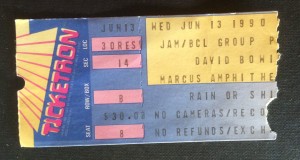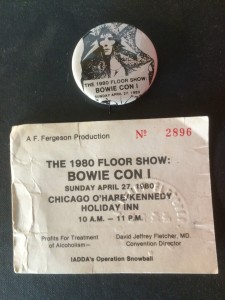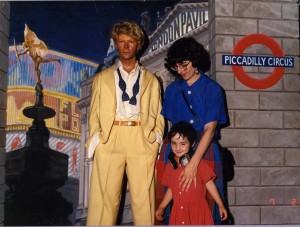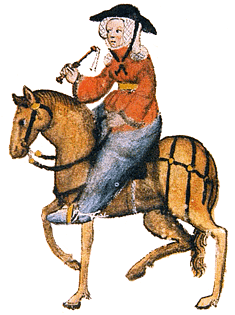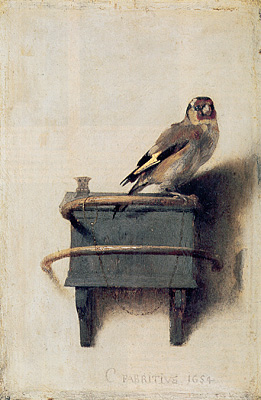I am going to break this time from the precedents I have established on this blog and just tell a story. Four years ago, while doing some volunteer research for the Wauwatosa Historical Society, I met Rupert Schmitt, Jr., on the internet and we became fast friends. Rupert is the grandson of Conrad Schmitt, founder of the Midwest’s most prominent stained glass studio in 1889. But that is not the story I would like to tell. Rather, the story is about Rupert, his siblings, and their place in an amazing chapter in American art history. Much of this comes from my conversations and emails with Rupert, and from Mary Emma Harris’ book, The Arts at Black Mountain College (MIT Press, 1987 & 2002)
In 1933, with $14,500 in pledges and buildings borrowed from the YMCA, a small group of educators and artists – among them Bauhaus refugees from the new Nazi Germany – came together near Asheville, North Carolina to found Black Mountain College. Josef Albers, having also fled Germany with his wife Anni, joined the faculty that first year, despite some resistance from the founders because Albers could not yet speak English. Meanwhile, in Wauwatosa, Wisconsin, Betty, Elaine and Conrad Schmitt were taking their crayons out of their desks at St. Jude the Apostle School; their younger brother Rupert Jr. was speaking his first words.
The Schmitt children’s grandfather, Conrad, founded the Conrad Schmitt Studios in Milwaukee in 1889. At their height, the Schmitt Studios were second only to Tiffany in stained glass production and quality. Conrad’s son and heir to the business, Rupert, built a Tudor-revival home for his family in Wauwatosa in 1926, many of the floor-to-ceiling leaded glass windows adorned with stained glass from the Studios. Rupert Schmitt’s wife Elizabeth grew orange poppies during the war, and painted them; his daughters raised sprouts in the kitchen; his sons played with their dogs and hiked in the woods; and the entire family enjoyed Gilles Frozen Custard in the summer.
In his book, The Interview and other poems (iUniverse, 2008), youngest son Rupert Schmitt Jr. writes:
… My sister Elaine spent her days
Drawing.
Father said, don’t draw movie stars
That is a waste of talent
I still have her drawings
My family playing bridge
Uncle Otto and my father Rupert
My mother Betty and Aunt Alma
There is a sketch of me
Curled up
Sleeping on the couch.
There is a drawing with colored red paint
Of my chickens and me
Although my sister got the coop
She could not draw the cluck.
Though sketching me curled forever on the couch
She left out my exhalation
And failed to catch my dreams.
Betty Schmitt (1923-2007) was the eldest of the Schmitt children and the first to enroll in Black Mountain. She came to study art with Albers in the mid-1940s, but left after a short time to study dance with Martha Graham in New York. Elaine Schmitt (1925-2004), who had already studied art at the Milwaukee State Teachers College for two years, followed Betty. In 1944, Elaine attended the Art Institute of Chicago’s summer school, but by 1945, Betty had persuaded their parents that Elaine belonged at Black Mountain studying with Albers, so she enrolled for the Summer Session, and remained for the Winter Session. Elaine studied drawing and design with Albers, and became known as the “Matière Mama.” In Albers’ matière studies students first handled objects to fully understand their qualities and textures, then drew only what they saw, with no reference to self-expression. According to the diary she kept during those years, Elaine drew a sketch of a pig’s stomach and Albers praised this piece enthusiastically, while adding “Now throw it out,” suggesting that it smelled. After the 1946 Summer Session, Elaine moved to New York, and later that year she married fellow Black Mountain alumnus John Urbain.
In 1946, Elaine’s Teachers College classmate, Ruth Asawa (1926-2013), joined her at Black Mountain. Ruth, the child of Japanese immigrant parents, was incarcerated at the Rohwer Relocation Center in Arizona when the Japanese American Student Relocation Council helped her obtain a relocation card in order to move to Milwaukee and study at the State Teachers College in 1943. Ruth attempted to obtain employment at the Schmitt Studios, but prejudice at the time prevented that. Similar prejudice prevented her from doing the student teaching her degree required, so she finished her studies at Black Mountain. Until her death just a few weeks ago, Ruth remained a practicing artist and sculptor in San Francisco, where the fountains she sculpted adorn many city parks.
Conrad (b. 1927) was the third of the Schmitt children to arrive at Black Mountain. Conrad had dropped out of Marquette High School at 17; worried about the draft as World War II raged on, he followed his sisters to Black Mountain. Once there, he helped build a stone wall and to plan a bridge over a stream and culvert (which he illustrated with an orange, lemon and apricot). Conrad dreamed of going to the Illinois Institute of Technology to study architecture with Ludwg Mies van der Rohe, but his father prevailed, and at 18, Conrad enrolled in Catholic University. Conrad Schmitt soon despaired of drawing renderings of gothic cathedrals at Catholic University, so he spent his time playing bridge in a local school and in a tavern but “Had a hard time getting graded for that.” Conrad dropped out of Catholic University after one semester. He moved to Greenwich Village and lived on MacDougal Street, as his brother Rupert writes:
Stayed in a cold water flat. In winter soot came in. The bathtub was in the kitchen, toilet in the hall…. Conrad twisted wires like Calder, drank wine and ate bread. He had his friend post letters from Washington D.C. This kept the story going. Dad sent money. Dad said, come home. ~ Email from Rupert Schmitt, September 30, 2009
Instead, Conrad returned to Black Mountain, and set up a glass studio. He had supervised stained glass installations at churches, learned stencil painting from the Schmitt Studios’ Augie Anderson, and worked with his brother Rupert on jobs in Wausau and Omaha. In his second time at Black Mountain, Conrad studied with Josef Albers, who thought he had much talent. He also studied with the mathematician Max Wilhelm Dehn, who fled Europe after Kristallnacht, taught briefly in Idaho, and came to Black Mountain in 1944. (A sketch of Dehn by Elaine Schmitt can be found on page 127 of Mary Emma Harris’ book.) After this second period at Black Mountain, Conrad attended the University of Chicago where he studied with Milton Friedman and ultimately received his MBA in Finance. Conrad went on to found insurance companies in Wisconsin and Minnesota, eight substance abuse and addiction treatment clinics, and several preventative medicine companies. In 2009, Conrad conferred with members of the Minnesota congressional delegation on the Affordable Care Act.
Betty Schmitt returned to Black Mountain in 1948 with her husband Warren “Pete” Jennerjahn (b. 1922), an art alumnus of the Milwaukee State Teachers College. In the summer of 1948, Josef Albers briefly took the helm of the democratic faculty/student-run school. Merce Cunningham, John Cage, Willem and Elaine de Kooning, Richard Lippold, Buckminster Fuller came to teach in the Summer Session, and Robert Rauschenberg first arrived as a student. That summer, Betty Schmitt Jennerjahn taught dance and worked and studied with Merce Cunningham, under whose direction she danced with Rauschenberg, while Pete, with funds remaining under the GI Bill, studied with Cunningham and John Cage, and worked as Albers’ assistant. Betty’s brother Rupert wrote the following poem, “Betty and Merce,” about a photograph taken during the 1948 Summer Session (which can be seen on page 157 of Harris’ book):
Elizabeth
AKA Leapy
Given that name by Pete
For obvious reasons
And Eskimo
Because of her eyes
When I think of the Sistine chapel fresco,
The index finger of God
The index finger of Michelangelo
Almost touching,
I recall Betty’s black and white image.
Her arm horizontal
Merce Cunningham’s arm
Reaching
Reaching
Reaching
For the light.
Both
Focussed, intent,
Still
Dancers
On tip toes
Dancing
Still.
Josef and Anni Albers resigned from Black Mountain in the spring of 1949, but not before securing Buckminster Fuller to lead the 1949 Summer Session. The Jennerjahns returned to teach silkscreen (Pete) and dance (Betty). During the summer session, Betty and Pete also performed in several of Charles Olson’s Verse & Theatre productions, and that fall the Jennerjahns created the Light-Sound-Movement Workshop. The Workshop interjected improvised theater, dance and music with projected images and text, and vast elaborate sets which often involved the audience as active – and costumed – participants, and Pete led his students to create their own percussion instruments. The Light-Sound-Movement Workshop did not continue in its established form once the Jennerjahns left Black Mountain in 1951, but the seeds had been planted; in the summer of 1952 John Cage staged his “Theater Piece #1” in the dining hall, which is now generally recognized as the first “Happening.”
After spending a year in France, the Jennerjahns moved to New York where Pete taught art at Hunter College and Cooper Union for a few years until they moved to Long Island. There, Pete taught at Adelphi University while Betty taught art at The Waldorf School of Garden City. The Jennerjahns continued to work in many media; Pete played the saxophone and clarinet and learned to play the flute in 1965. Later he and their son Hans composed music for flute and guitar. Several years ago, the Jennerjahns participated in an exhibition of Black Mountain artists at the Museo del Prado in Madrid. The Jennerjahns moved to Sedona, Arizona, where Betty died in 2007. Betty’s watercolor, Still Life (Basket of Fruit), is in the collection of Harvard University Art Museums – a gift of Josef Albers – and is reproduced on page 83 of Mary Emma Harris’ book.
In 1997 Betty wrote:
My creative life has gone through many stages; art student, dancer, maker of wall hangings, painter. The last stages of my paintings were landscapes and then waterfalls, both east and west. But last year I wanted to move away from references to the natural world, but I didn’t know how to do it in a way that was valid for me….I find, after a time, a feeling of comfort and familiarity. I am working in the way I did when I would toss a piece of lace across some velvet in a way that spoke to me. Or I am carried back to doing a color study with Albers at Black Mountain College, or in Switzerland with Herr Wagner painting a yellow and blue exercise. But perhaps most amazing to me is to be back to doing the crayon drawings I loved at St. Jude’s School.
After Black Mountain, Elaine and John Urbain moved to Paris for a year in 1950, so Elaine could study at the Academie Julien. The Urbains became well known for their many stained glass mural commissions for clients such as Anheuser-Busch, Niemann-Marcus and the University of Louisville. John eventually became the Artistic Director at Philip Morris. One of the Urbains’ most renowned commissions is a stained glass panel illustrating 16th Century essayist Michel de Montaigne’s “On being a citizen of the world.” This piece, commissioned by the Container Corporation of America in 1950, is now in the collection of the Smithsonian Institution (1984.124.294).

Portrait of Lucy Swift, c. 1945, Elaine Schmitt Urbain, Collection of the Asheville Art Museum
However, Elaine became even better known for the socially and politically conscious portraits she drew in the 1960s, 70s and 80s. She was actively involved in the anti-war movement in the 1960s, as a member of the War Resisters League and the Catholic Peace Fellowship. In 1963, she travelled to Rome as a delegate of the Women’s International Peace Pilgrimage to speak to the Pope. In the 1980s she lived in Mallorca, ran a gallery there (funded by her brother Conrad) and became known as “the Artist of the People.” The Urbains ultimately divorced, and Elaine died in Milford, Connecticut, in 2004; John died in April, 2009. The Asheville Art Museum is home to a number of Elaine’s works, donated by John and their son, Michael.
The social conscience Elaine displayed as an adult had its roots in her youth, as her brother Rupert writes in his poem, “My sister Elaine Pied Piper of the Urban League”
I remember
Elaine led us,
To our backyard.
Seven black kids
One white boy.
The black kids
Stepped carefully from Lannon stone to Lannon stone
As if avoiding
Alligators.
I was also afraid.
In the photograph
We are sitting
In a semi circle
Around a campfire
Toasting marshmallows
In Wauwatosa
A middle class suburb
Of Milwaukee
Wisconsin.
Rupert Schmitt Jr. (b.1932), whose poetry, family archives, emails, phone calls and memories inform this essay, attended Black Mountain in 1950, after graduating from Wauwatosa High School (now Wauwatosa East). Rupert Jr. studied writing at Black Mountain, after which he earned his BS and MS, attending several state schools. For many years Rupert earned his living as a consulting biologist, a technical writer, and a faculty member of a community college. He is currently an artist in residence at the Curley School Center for the Arts in Ajo, Arizona, where he wrote The Interview, a novel, The Mad Professor (iUniverse, 2011), and is working on his memoirs. He maintains a blog “Holed up in Ajo,” and has displayed his wood carvings in the Day of the Dead Show in Ajo. Both The Interview and The Mad Professor are available through Amazon, or directly from Rupert.
In the summer of 2007, works by both Jennerjahns and both Urbains were exhibited in a group show called “Up From New York” at Maine’s Damariscotta’s Gallery 170. In 2011, Pete Jennerjahn exhibited at Yvette Torres Fine Art in Rockland, Maine, which continues to display his work and the work of dozens of Black Mountain alumni on their website. Black Mountain College closed its doors permanently in 1957, several years after the last of the Schmitt children attended; its history lives on at the Black Mountain College Museum + Arts Center in Asheville, North Carolina, and with the Black Mountain College Project, chaired and directed by Mary Emma Harris.
© 2013 Sarah Bernstein
Like this:
Like Loading...
